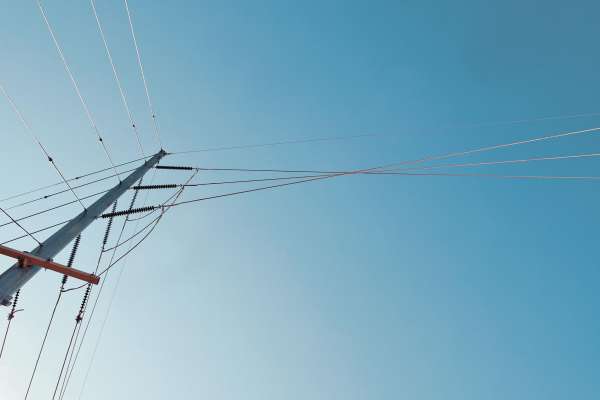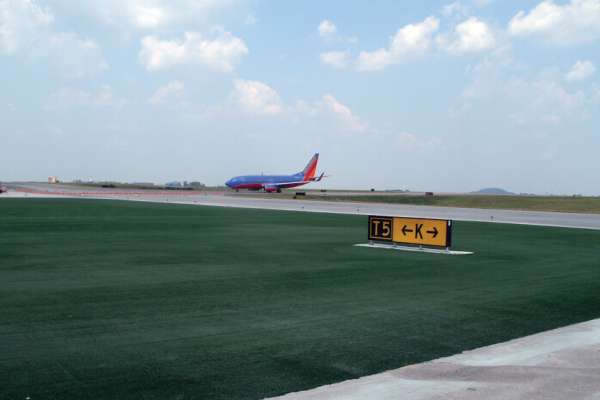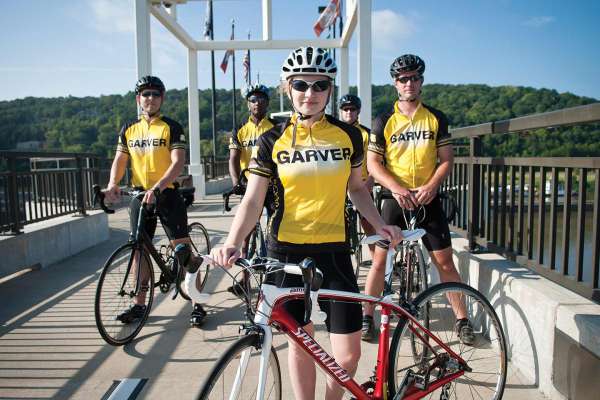Enhancing safety and efficiency at Nashville International
Three projects at Nashville International Airport in Tennessee are changing the way pilots, air traffic control and the aviation industry view the airfield. Garver's recent projects improved landside and airside lines of sight, reconfigured how taxiways interact and installed airside synthetic turf.
Broad Perspective
Runway 2C/20C's departure end is in a low-lying area with multiple taxiway connections and a non-standard hold pad. Garver realigned this area to provide general aviation and commercial airlines with improved access to the center runway, which ultimately makes it safer and operate more efficiently. However, before moving forward with design, Garver sought to understand the broader perspective.
"You have to investigate the airport's history, its legacy projects, to understand present conditions and how best to make improvements," said Garver Project Manager Ryan Sisemore, PE.
During an American Airlines hub build-out 20 years ago, Center Runway 2C/20C was rebuilt to handle an increase in commercial traffic, and the original runway was converted to serve as its parallel taxiway, later designated as Sierra. However, the taxiway retained several of its runway features, including a 150-foot pavement width.
"When the new runway opened, the airport closed a segment of Taxiway Sierra between the S7 and S5 connectors to make sure pilots didn't attempt to use the old runway for departure," Sisemore said. "That portion of the taxiway has remained closed for at least a decade until our project."
To improve airport operations within the area, Garver reconfigured how the runway and taxiway connectors interact. This involved rebuilding the taxiway with standard widths and reopening its service, extending Taxiway S6 through to the runway to allow better queuing and improve mixed-use traffic operations, and rehabilitating the remaining concrete pavements in the area.
"Reconfiguring the taxiways improves pilot navigation in the area," said Robert Ramsey, PE, Metropolitan Nashville Airport Authority Assistant Vice President of Planning and Design. "It also improves overall traffic congestion by adding greater separation between commercial and general aviation aircraft."
Enhanced Perspective
A second project enhanced line of sight between the air traffic control tower and aircraft movement on Taxiway Uniform. Garver provided services to extend adjacent Taxiway T5 and route airplanes farther into the airfield. Taxiway Uniform was then removed from the tower's controlled area.
Garver conducted a line-of-sight study to improve air traffic control's ground movement perspective. Sisemore met with tower operators and visited the tower's top floor to get a bird's eye view of the airfield. Garver also created a 3D model for the airport authority that illustrated how to enhance air traffic controllers' sight lines.
"The ensuing project resulted in extending a nearby taxiway about 500 feet and moving traffic deeper into the airfield," Sisemore said. "This improved both efficiency and safety."
Fresh Perspective
Nashville International decided to take the non-standard S7 hold pad out of service, which traditionally involves demolition. Instead, the Airport Authority selected a unique fix that offers a new perspective on how to handle excess airfield pavement—synthetic turf.
"We had the option to tear out the 18-inch concrete pavement, which is some of the best on the airfield, or leave it in place," Ramsey said. "We decided to cover the pavement with a synthetic turf in the event that we need it as a runup or holding area in the future. We also selected the synthetic turf instead of using non-traffic marking and lighting because of its heightened visual contrast."
Construction crews installed 9,335 square yards of synthetic turf, which resists jet blast, weather effects, airfield contaminants and fire. A 2-inch-tall mat sits on a thin base, and sand infill provides rigidity and drainage. The turf is unrolled in strips and adhered to the pavement. It also installs within a few days as compared to a demolition process that can take weeks.
"Nashville International is one of the first air carrier airports in the Southern Region to install airside synthetic turf," Sisemore said. "It doesn't attract wildlife which can endanger aircraft, it cuts down on maintenance and it gives the airport flexibility to bring the hold pad back into service at a later date."






Share this article